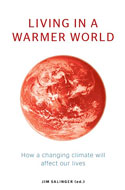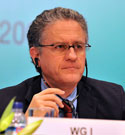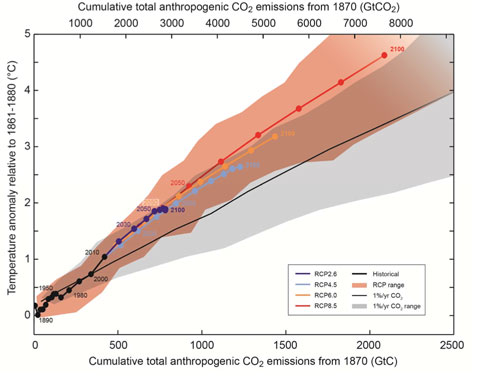 Over at The Daily Blog today, in a post headlined The Inconvenient Neighbours, I consider the case of the Kiribati man who is claiming refugee status in New Zealand because of the impact of sea level rise on his home island. With the IPCC report suggesting that sea level could rise by as much as a metre this century, it’s surely a sign of things to come…
Over at The Daily Blog today, in a post headlined The Inconvenient Neighbours, I consider the case of the Kiribati man who is claiming refugee status in New Zealand because of the impact of sea level rise on his home island. With the IPCC report suggesting that sea level could rise by as much as a metre this century, it’s surely a sign of things to come…
Author: Gareth
The last refuge of scoundrels
 Tomorrow, in the Appeal Court in Wellington (pdf), Justices Harrison, French and Miller will hear argument in the case of the NZ Climate Science “Education” Trust (NZCSET) versus the National Institute for Water and Atmospheric Research (NIWA), in the continuing effort of the cranks to litigate away warming in New Zealand over the last 150 years. According to the man who kicked off the whole process, Richard Treadgold of the “Climate Conversation” web site, the NZCSET bases its appeal on two main points:
Tomorrow, in the Appeal Court in Wellington (pdf), Justices Harrison, French and Miller will hear argument in the case of the NZ Climate Science “Education” Trust (NZCSET) versus the National Institute for Water and Atmospheric Research (NIWA), in the continuing effort of the cranks to litigate away warming in New Zealand over the last 150 years. According to the man who kicked off the whole process, Richard Treadgold of the “Climate Conversation” web site, the NZCSET bases its appeal on two main points:
The focussed grounds are that all three NIWA temperature series resulted from serious mistakes of fact, which impugned the rationality of the Crown Entity’s decisions.
This seems somewhat surprising, given that the judge in the original case was so scathing of the NZCSET’s expertise in his judgement delivered a year ago. One wonders how the Appeal Court will react to any attempt to relitigate the original decision, given Justice Venning’s findings. But then perhaps the whole appeal has rather more to do with the second basis for appeal:
The Coalition is also seeking reversal of the High Court’s costs order.
Costs of $118,000 were awarded against the NZCSET — a trust formed specifically to bring the original court case, and which did not legally exist until weeks after the original court documents were filed. Could it be that the trustees of the NZCSET, being Terry Dunleavy, Bryan Leyland and Doug Edmeades ((According to the certificate of incorporation: go here, click on Register Search, insert 2539286 in the appropriate box, and click “search”.)), aren’t happy to pay the costs incurred by their leader and legal eagle, Barry Brill? One hopes that they’re not planning to fold the trust in the event that their appeal isn’t successful, thus avoiding having to pay NIWA’s costs. After all, they founded the trust with lofty aims:
… to promote a heightened awareness and understanding of, and knowledge about, the climate, environment and climate and environmental issues among scholars and researchers, members of the professions and members of the public… (see Sec 4.1.1 of the certificate)
I have a few questions for the trustees:
- How much money has the trust disbursed amongst scholars and researchers since it was established on July 30, 2010? Over three years of fund raising and charitable endeavour has surely delivered more than a footling little court case?
- In what ways, other than by bringing an unsuccessful court case, has the trust “heightened awareness and understanding of climate”?
- In the event that you are unsuccessful in your appeal, are you planning to pay up in full for the costs awarded against you by Justice Venning? If not, why not?
I eagerly await assurances from the NZ Climate Science Education Trust that their laudable education effort continues, and that it has adequate funds to meet the costs they’ve incurred by taking NIWA to court. No doubt they will have plans for further and more productive education efforts in the near future. But I won’t be holding my breath…
Update: Tuesday 15th @ 3-50pm
Word reaches me that the NZCSET have just capitulated and abandoned their appeal against Justice Venning’s decision — in other words, a comprehensive victory for NIWA and a further vindication of the work done by their team on the NZ temperature record. The Appeal judges have reserved their judgement on costs, but it’s possible that the NZCSET’s legal bill might just have increased a fair bit.
Salinger’s warmer world book tour
 Jim Salinger’s latest book on climate change — Living in a warmer world — was launched last night in Auckland. Jim’s pulled together contributions from some of the world’s leading researchers to illustrate what climate change really means for the way we will live in the future, including Ove Hoegh-Guldberg on coral reefs, John Church on sea level rise, Greg Jones on viticulture, Glenn McGregor on heatwaves, Jan Sinclair on media framing of climate, and Jonathan Boston on ethical issues. Jim and Trevor Chinn have penned the chapter on glaciers response to warming, and it’s packed full of interesting news about NZ’s ice loss (of which more later). It promises to be a fascinating and informative look at what’s coming down the track, and a useful companion to the IPCC’s new report. I’ll have a full review of the book up at Hot Topic in due course.
Jim Salinger’s latest book on climate change — Living in a warmer world — was launched last night in Auckland. Jim’s pulled together contributions from some of the world’s leading researchers to illustrate what climate change really means for the way we will live in the future, including Ove Hoegh-Guldberg on coral reefs, John Church on sea level rise, Greg Jones on viticulture, Glenn McGregor on heatwaves, Jan Sinclair on media framing of climate, and Jonathan Boston on ethical issues. Jim and Trevor Chinn have penned the chapter on glaciers response to warming, and it’s packed full of interesting news about NZ’s ice loss (of which more later). It promises to be a fascinating and informative look at what’s coming down the track, and a useful companion to the IPCC’s new report. I’ll have a full review of the book up at Hot Topic in due course.
Over the next couple of months, Jim will be touring New Zealand, presenting key points from the book. His first gigs will be in Nelson on Sunday. Full details below the fold…
Stocker in Wellington: RSNZ to stream AR5 science workshop
 Swiss climate scientist Thomas Stocker, joint chairman of the IPCC’s Working Group One, is in New Zealand for a few days, and the NZ Climate Change Centre and the Royal Society of NZ have taken the opportunity to put together a stakeholder workshop to allow Stocker and NZ lead authors to present the key findings of the recently published AR5 WG1 report. The workshop is being held tomorrow, Friday 11th, from 9am to 1pm at the RSNZ in Wellington, and is open to the public (spaces limited, register here). For the geographically challenged, the event will be web-cast live.
Swiss climate scientist Thomas Stocker, joint chairman of the IPCC’s Working Group One, is in New Zealand for a few days, and the NZ Climate Change Centre and the Royal Society of NZ have taken the opportunity to put together a stakeholder workshop to allow Stocker and NZ lead authors to present the key findings of the recently published AR5 WG1 report. The workshop is being held tomorrow, Friday 11th, from 9am to 1pm at the RSNZ in Wellington, and is open to the public (spaces limited, register here). For the geographically challenged, the event will be web-cast live.
The workshop will open with an introduction by Richard Bedford, a council member of the RSNZ, and an overview of the IPCC process by WG1 vice-chair David Wratt. Stocker will present the key Working Group I report findings from about 9-10am. NZ’s coterie of lead authors — Dave Frame, Tim Naish, and Jim Renwick — will provide snapshots of the parts of the report they were involved with. From midday on, the Science Media Centre’s Peter Griffin will chair a “stakeholder panel” including Rod Oram, Federated Farmers vice-chair William Rolleston and Frances Sullivan from Local Government NZ to discuss how the report has been received and what it means for New Zealand.
Stocker is also being interviewed by Radio NZ National’s science correspondent Veronika Meduna, and that should be broadcast in her show next week.
We did it and it’s going to get worse, but it’s not (yet) too late: IPCC AR5 science report summary released
Aafter all the leaks and attempted spin, the final version of the IPCC’s Summary For Policymakers of the Working Group One report on the physical science basis for our current understanding of climate change has just been released. Download the PDF from the IPCC site here. The full report will follow on Monday — a massive 3,000 page tome that summarises 9,200 scientific papers published since AR4 was released in 2007. The bottom line is clear enough:
Warming of the climate system is unequivocal, and since the 1950s, many of the observed changes are unprecedented over decades to millennia. The atmosphere and ocean have warmed, the amounts of snow and ice have diminished, sea level has risen, and the concentrations of greenhouse gases have increased.
The Science Media Centre asked Professor Dave Frame, Director of the NZ Climate Change Research Institute at VUW to explain the key points:
- It is extremely likely that human activities caused more than half of the observed increase in global mean surface temperature since 1950;
- It is virtually certain that natural variability alone cannot account for the observed global warming since 1950;
- Global mean temperatures will continue to rise over the 21st century if greenhouse gas emissions continue unabated;
- The principal driver of long term warming is the total cumulative emission of CO2 over time;
- To limit warming caused by CO2 emissions alone to be likely less than 2°C, total CO2 emissions from all anthropogenic sources would need to be limited to a cumulative budget of about one trillion tonnes of carbon, emitted as CO2, over the entire industrial era, about half of which have been emitted by 2011.
The emphasis on carbon budgets is new for this report, and makes the emissions reduction challenge we face only too clear. Here’s Fig 10 from the SPM:

The black dots on the bottom left represent historical carbon emissions up to 2010. The various coloured lines show what various emissions pathways — new for AR5 (see Skeptical Science’s explanation) — mean for global temperatures by 2100. Only the most aggressive emissions pathway — RCP 2.6, the purple line — gives us a chance of staying under a 2ºC target, but assumes that we are actually reducing atmospheric CO2 by the end of the century. It remains an uphill struggle, in other words, and the hill gets steeper the longer we leave starting out on the climb.
